ESP AUDI A5 COUPE 2011 Owners Manual
[x] Cancel search | Manufacturer: AUDI, Model Year: 2011, Model line: A5 COUPE, Model: AUDI A5 COUPE 2011Pages: 362, PDF Size: 84.88 MB
Page 308 of 362
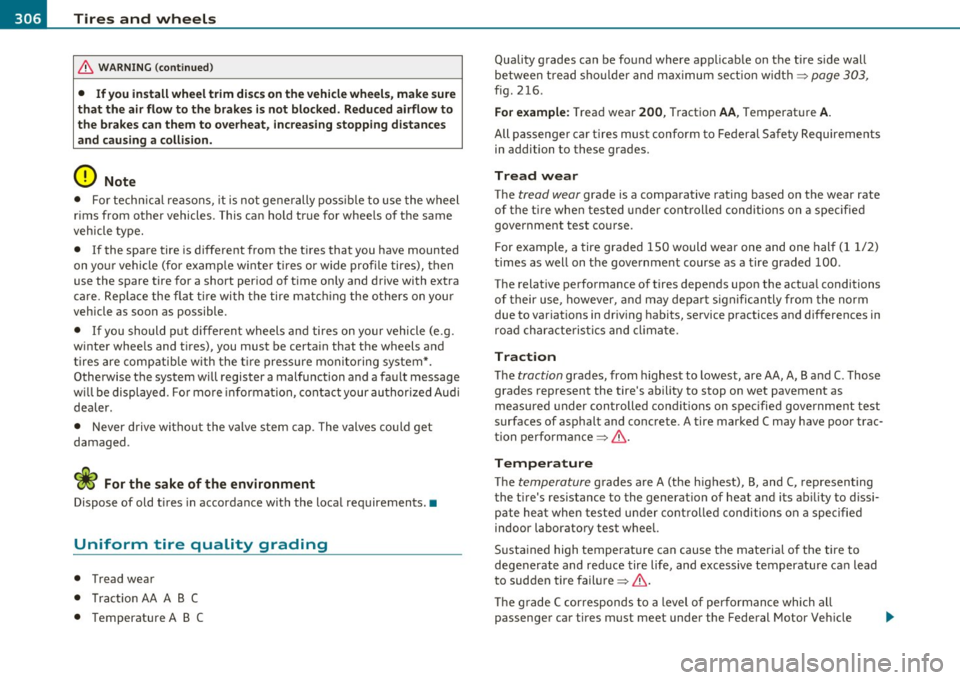
-~_T_ i_ re _ s_ a_n _ d_ w_ h _e_ e_ ls _________________________________________________ _
& WARNING (conti nu ed )
• If you install wheel trim disc s on the vehicle wheels , make sure
that the air flow to the brakes is not blocked . Reduced airflow to
the brakes can them to ove rhe at, increasing stopping distances
and cau sing a collision .
0 Note
• For tech nical reasons, it is not ge ne rally poss ib le to use the wheel
r ims from other vehicles. This can hold true for whee ls of the same
veh icle type.
• If the spare tire is different from the t ires that you have mounted
on yo ur veh icle (for examp le w inte r tir es or wide profile tires), then
use the spare tire for a short per iod of t ime on ly and drive with extra
c are . Replace the fla t ti re wi th t he tire matc hing the o thers on you r
vehicle as soon as possible .
• If you should put differen t wheel s and tires o n yo ur vehicle (e.g.
w inter whee ls and t ires), you must be certa in that the wheels and
ti res are comp atib le with the t ire pressure mon ito ring system*.
Otherwise the system will register a malfu nction and a fau lt message
w ill be displ ayed. Fo r more informa tion, conta ct your au thori zed Au di
dealer.
• N ever drive wi tho ut the valve s tem cap. The valves co uld get
damaged .
Uniform tire quality grading
• Tread wear
• Tr act io n AA A B C
• T emperature A B C Quality grades can be fo
und where app licab le on the tire s ide wall
betwee n tre ad sho uld er and m aximum se ct io n width =>
page 3 03,
fig .216.
Fo r example : Tread wea r 200, Tract ion AA , Temperat ure A.
All passenge r car ti res mus t confo rm to Fe d er al Safety Requireme nts
in addition to these grades.
Tread wear
T he tread wear grade is a comparative rating based on the wear rate
of the t ire whe n tes ted under cont rolle d conditions on a specifie d
government test co urse.
F or example, a tire graded 150 would wear one a nd one hal f (1 1/2)
t imes as well on t he government course as a tire graded 100 .
The relat ive performance o f tires depen ds upon the act ua l conditions
of their use, however, and may de pa rt sign ifican tly from the no rm
due to variat ions in dr iv ing hab its, se rvice practices and differences in
ro ad characte ris tic s and climat e.
Traction
Th e traction grades, from high est to lowest, ar e AA, A, Band C. Those
grades represent the tire's ability to stop on wet pavement as
me asu red under con trolled conditions on spe cifie d gove rnme nt te st
surfaces of asphalt and conc rete . A tire marked C may have poo r trac
ti on perfo rm an ce =>& .
Temperature
The temperature grades a re A (the h ig hest), B, and C, represen ting
the t ire's resistance to the generation of heat and its ab ility to d issi
p ate he at when teste d und er co ntro lled condition s on a s pecifie d
indoor laboratory test wheel.
Susta ined high tempera ture can cause the materi al of the tire to
degenerate and red uce tire life, and excessive te mperature ca n lead
to sudden tire failure=> & .
Th e g ra d e C c orresponds to a level of pe rforman ce which all
passenge r ca r tires must meet under the Federal Motor Veh icle
Page 312 of 362
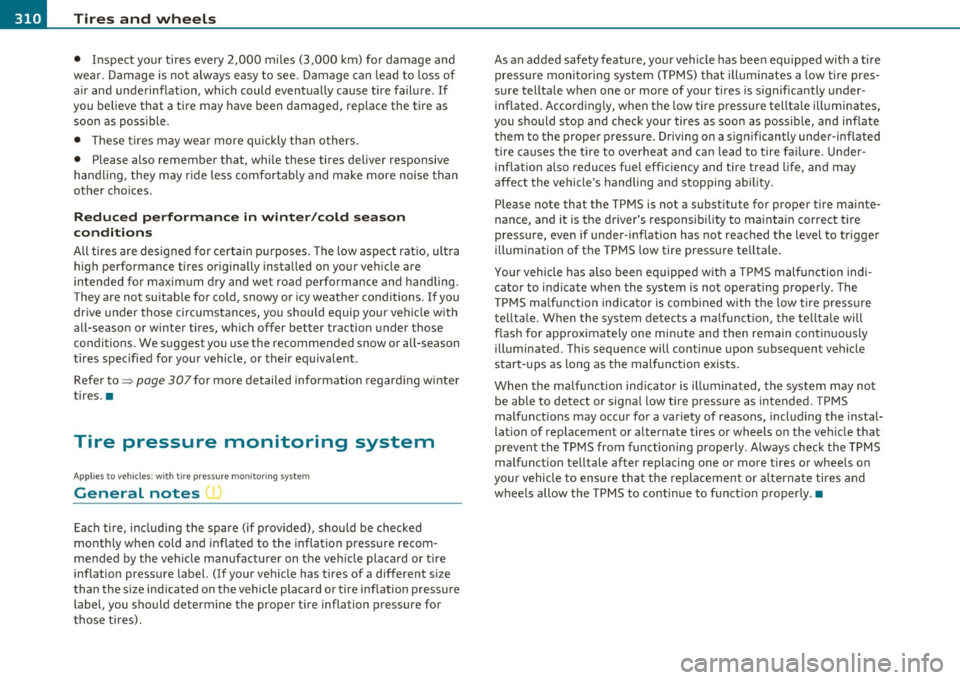
-~_T_ i_ re _ s_ a_n _ d_ w_ h _e_ e_ ls _________________________________________________ _
• Inspect your tires every 2,000 miles (3,000 km) for damage and
wear . Damage is not always easy to see. Damage can lead to loss of
air and underinflat ion, which could eventually cause tire failure. If
you believe that a tire may have been damaged, replace the tire as
soon as poss ible .
• Th ese tires may wear more quickly than others.
• Please also remember that, whi le these tires deliver responsive
hand ling, they may ride less comfortably and make more noise than
other choices.
Reduced performance in winter/cold season
conditions
All tires are designed for certain purposes. The low aspect rat io, ultra
high performance tires originally installed on your vehicle are
intended for maxim um dry and wet road performance and handling.
They are not suitable for cold, snowy or icy weather conditions . If you
drive under those circumstances, you should equip your vehicle with
all-season or winter tires, which offer better traction under those
conditions. We suggest you use the recommended snow or all-season
tires specified for your vehicle, or their equivalent.
Refer to=:,
page 307for more detailed information regarding winter
tires .•
Tire pressure monitoring system
Ap plies to ve hicl es : w it h t ire pressur e m onito rin g syst em
General notes
Each tire , including the spare (if provided), shou ld be checked
month ly when cold and inflated to the inflation pressure recom
mended by the veh icle manufacturer on the vehicle placard or t ire
inf lation pressure label. (If your vehicle has t ires of a diffe rent size
than the siz e indicated on the vehicle placard or tire inflation pressure
label, you should determine the proper tire inflation pressure for
those tires). As
an added safety feature, your vehicle has been equipped with a tire
pressure monitoring system (TPMS) that illumi nates a lo w tire pres
sure telltale when one or more of your tires is significantly under
inflated. Accordingly, when the low tire pressure telltale illuminates,
you should stop and check your tires as soon as possible, and inflate
them to the proper pressure. Driving on a significantly under-inflated
tire causes the tire to overheat and can lead to tire failure . Under
inf lation also reduces fuel efficiency and tire tread life, and may
affect the vehicle's handling and stopping ability.
Please note tha t the TPMS is not a substitute for proper tire mainte
nance, and it is the driver's responsibility to maintain correct tire
pressure, even if under-inflation has not reached the level to trigger
illumination of the TPMS low tire pressure telltale.
Your vehicle has also been equipped with a TPMS malfunction indi
cator to indicate when the system is not operating properly. The
TPMS malfunction indicator is comb ined with the low tire pressure
telltale. When the system detects a malfunction, the telltale will
flash for approximately one minute and then remain continuously
illuminated. This sequence will continue upon subsequent vehicle
start-ups as long as the malfunction exists.
When the ma lfunction ind icator is illuminated, the system may not
be able to detect or signal low tire pressure as intended. TPMS
malfunctions may occur for a variety of reasons, including the insta l
lation of replacement or alternate tires or wheels on the veh icle that
prevent the TPMS from functioning properly. Always check the TPMS
malfunction telltale after replacing one or more tires or wheels on
your vehicle to ensure that the replacement or alternate tires and
wheels allow the TPMS to cont inue to function properly. •
Page 314 of 362

Ill Tires and wheels
-------------------
& WARNING (continued)
overheat and can lead to tire failure . Under-inflation also is likely
to impair the vehicle's handling and stopping ability.
• The driver is responsible for maintaining the correct tire pres·
sures. You must check the tire pressures regularly.
• Under certain conditions (such as a sporty driving style, winter
conditions or unpaved roads), the pressure monitor indicator may
be delayed.
• Ask your authorized Audi dealer if run-flat tires may be used on
your vehicle. Your vehicle registration becomes invalid if you use
these tires when not permitted. Damage to your vehicle or acci
dents could also result.
[ i J Tips
• The tire pressure monitoring system stops working when there is
an ESP/ABS malfunction.
• Using snow chains may resu lt in a system ma lfunction .
• To ensure a proper TPMS function use AUDI Original Tires which
are marked with "AO" or "RO" on the tire sidewall. =>
page 303.
• The tire pressure monitor ing system on your Audi was calibrated
using tires with the "AO" or "RO" identification. We recommend
using these tires.•
Applies to vehicles: with tir e pressure monitoring system
Reset tire pressure monitoring system
If the tire pressure is adjusted, wheels are rotated or
changed, the TPMS must be reset via radio or MMI*.
-Turn on the ignition.
- Select: the [ CAR] function button
> Tire pressure
monitoring
> Store now.
W Tips
Before resetting the TPMS, the current pressures of all four t ires
must correspond to the specified values . Adjust the tire pressure and
reset the pressure in the tire pressure monitoring system according
to the load you are carrying=>
page 295. •
Page 329 of 362
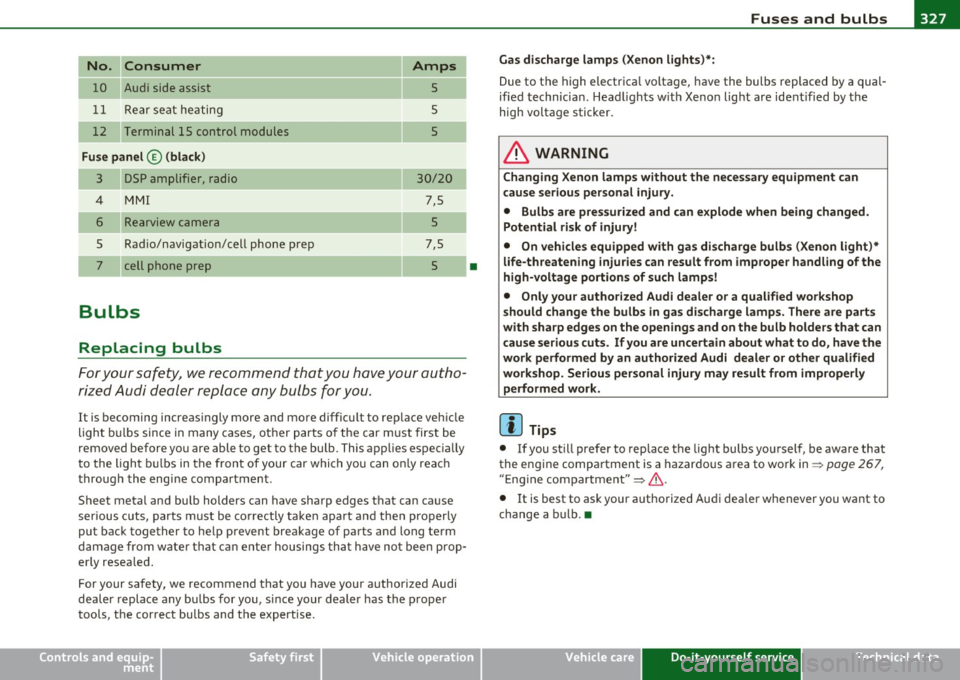
_______________________________________________ F_u _s_ e_ s_ a_ n_ d_ b_u _ l_ b _ s __ lR
No. I I Consumer
1 0 A udi side assis t
1 1 Rea r seat he ating
1 2 T ermin al 15 control mod ules
Fuse panel © (black)
3 D 5P amplifi er, rad io
4 MMI
5
Rea rvi ew c amer a
Rad io/nav igatio n/cell phon e prep
cell phone prep
Bulbs
Replacing bulbs
Amps
5
5
5
30/ 20
7,5
5
7,5
5 •
For your sa fety, we recommend tha t you have your autho
ri zed A udi de aler repl ace any bulbs for y ou.
It is becoming increas ingly more and more difficu lt to replace veh icle
ligh t bulbs since in many cases, other parts o f the car m ust first be
removed before you are able to get to the bu lb. This app lies espec ia lly
t o the ligh t bulbs in the fron t of your car which you can on ly reac h
t hroug h the engi ne compartment .
Sheet meta l and bu lb holders can have sharp edges that can ca use
serious cuts, parts must be co rrectly take n apart a nd the n properly
put back together to he lp prevent breakage of parts and long term
damage from w ate r that c an ente r housings tha t have no t been prop
er ly resea led.
F or your safety, we recommend that you have your authorized Audi
dealer replace any bu lbs for you, s ince your dealer has the p rope r
too ls, the cor rect bu lbs and the expertise.
Safety first Gas discharge lamps
(Xenon lights}*:
Due to the high electr ica l voltage, have the bulbs replaced by a qual
ified technicia n. Headl ights w it h Xe non lig ht are ident ified by t he
high voltage sticker.
& WARNING
Changing Xenon lamp s without the nece ssary equipment can
cause serious personal injury.
• Bulbs are pre ssurized and can explode when being changed.
Potential risk of injury!
• On vehicle s equipp ed with ga s discharge bulbs (Xenon light)*
life-threatening injuries can result from improper handling of the
high-voltage portions of such lamps!
• Only your authorized Audi dealer or a qualified workshop
s hould change the bulbs in gas discharge lamp s. There are parts
with sharp edges on the openings and on the bulb holders that can
c au se seriou s cuts. If you are uncertain about what to do , have the
work performed by an authoriz ed Audi dealer or other qualified
workshop. Seriou s person al injury may result from improperly
performed work.
(I] Tips
• If you st ill prefer to replace t he lig ht bulbs yourself, be aware that
the engine compartment is a hazardo us a rea to work in:::)
page 267 ,
" E ng ine compartme nt" :::) & .
• It is best to ask your a uthorized Au di dea ler w henever you wa nt to
change a b ulb. •
Vehicle care Do-it-yourself service Technical data
Page 336 of 362

lffll.___E_ m_ e_ r-' g=- e_n_ c=-y _ s_it _ u _ a_t_ i_ o _ n_ s ______________________________________________ _
in. WARNING
• To reduce the risk of serious injury and vehicle damage.
-Always lift the vehicle only at the special workshop hoist and
floor jack lift points illustrated
=> page 333, fig. 238 and
=> page 333, fig. 239.
- Failure to lift the vehicle at these points could cause the
vehicle to tilt or fall from a lift if there is a change in vehicle
weight distribution and balance. This might happen, for
example, when heavy components such as the engine block or
transmission are removed.
• When removing heavy components like these, anchor vehicle
to hoist or add corresponding weights to maintain the center of
gravity. Otherwise, the vehicle might tilt or slip off the hoist,
causing serious personal injury.
0 Note
• Be aware of the following points before lifting the vehicle :
-The vehicle should never be lifted or jacked up from under
neath the engine oil pan, the transmission housing, the front or
rear axle or the body side members. This could lead to serious
damage.
- To avoid damage to the underbody or chassis frame, a rubber
pad must be inserted between the floor jack and the lift points.
- Before driving over a workshop hoist, check that the vehicle
weight does not exceed the permissible lifting capacity of the hoist.
- Before driving over a workshop hoist, ensure that there is sufficient clearance between the hoist and low parts of the
vehicle. •
Page 342 of 362
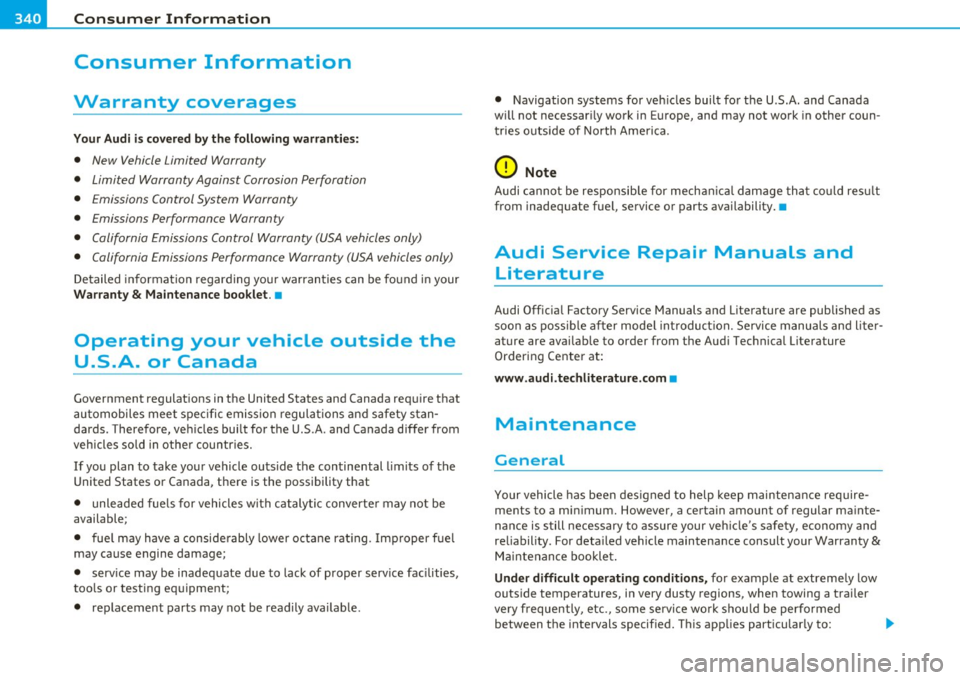
___ C_ o_n_ s _ u_m_ e_ r_ I_ n_ f_o _r_ m_ a_ t_io _ n _____________________________________________ _
Consumer Information
Warranty coverages
Your Audi is cov ered by the following warrantie s:
• New Vehicle Limited Warranty
• Limited Warranty Against Corrosion Perforation
• Emissions Control System Warranty
• Emissions Performance Warrant y
• California Emissions Control Warranty (USA vehicles only)
• California Emissions Performance Warranty (USA vehicles only)
Detailed informa tion regarding your warran ties can be fo und in your
Warranty & Maintenance boo klet .•
Operating your vehicle outside the
U.S.A. or Canada
Government regulat ions in the United States and Canada req uire t hat
au tomobiles meet spe cific emi ss ion regula tions and safe ty s tan
dards . There fore, ve hicles bui lt for the U.S.A . and Canada differ from
vehicles so ld in othe r countries.
If you plan to take your vehicle ou tside the continental lim its of the
United States or Canada, the re is the possibility that
• unle aded fue ls for vehicle s w ith c ataly tic converte r may n ot be
available;
• fue l may have a conside rably lower octa ne rat ing . Imp roper f ue l
may cause engine damage;
• serv ice may be inadequate due to lack of proper serv ice fac ilities,
too ls or testing eq uipment;
• replacement parts may not be read ily avai lab le . • N
avigation syst ems for veh icles built fo r th e U.S.A. and Canada
w ill not necessar ily work in Europe, and may not wo rk in other coun
tries outside of North Ame ric a.
0 Note
Audi canno t be responsib le for mech anical dam age th at could res ult
from inadeq uate fue l, se rvice o r parts ava ilability. •
Audi Service Repair Manuals and
Literature
Audi Off ic ia l Facto ry Service Manuals and Lite rature are published as
so on as p ossible a fter mode l int rodu ct ion. Service manu als and liter
ature are avai lab le to order from t he Aud i Tec hnical Lite rature
O rder ing Cente r at:
www.audi .techliterature .com •
Maintenance
General
Your vehicle has been des igned t o help keep m ainten ance re quire
ments to a min imum. However, a certain amount of regular ma inte
n an ce i s still ne cessary to assure your ve hicle's sa fe ty, ec onomy and
re liability . For deta iled veh icle maintena nce consult your Warranty
&
Maint enance bookle t.
Under difficult operating conditions, for example at extreme ly low
outs ide temperatures, in very dusty regions , when towing a trai le r
very frequent ly, etc., some se rv ic e w ork s hou ld be perfo rmed
between t he intervals specif ied. This app lies part icularly to: .,_
Page 343 of 362

______________________________________________ C _o_ n _ s_u_ m_ e_r_ I_n _f_ o_ r_m _ a_t_ i_ o _ n __ _
• oil cha nges, and
• cl ea ning or re placing th e air fi lter.
W For the sake of the environment
By regu larly ma intaini ng yo ur vehicl e, y ou h elp m ake su re th at em is
sion standards a re mainta ined, t hus mi nimizing adverse effects o n
t he enviro nmen t. •
Important considerations for you and your
vehicle
Th e increas ing use of elect ronics, s ophistica ted fuel inje ct io n and
em ission cont rol systems, and t he generally increasing tec hnical
c omplex ity o f today' s automobile s, have s tea dil y re duced t he s cope
of maintena nce and repairs w hic h can be carr ied out by ve hicle
ow ners.
Also, safety and environmental c o nce rn s plac e very s trict
limits o n the nature of repa irs and adjustments to engine an d tra ns
mission parts w hich an owner can pe rform .
M ain te nance, ad justm ents and r epairs us ua lly re quir e spec ia l t ools,
test ing devices an d other e quipment availab le to s pecia lly trained
wo rksh op pe rsonnel in order to assure pro per perfor mance, re li
ability and safety of the vehicle and its many systems.
Impro per ma inte nance, adjustments and rep airs can im pa ir the ope r
ation and reliability of your ve hicle and even void your veh icle
wa rranty . Therefo re, p ro of of se rvicing in a ccordance wi th t he ma in
t enance sch edul e may be a co nd it io n fo r u phold ing a possib le
wa rranty claim made w it h in the wa rranty pe riod.
Above all, operat io nal safety ca n be adve rsely affec ted, c reat ing
unnecessary r is ks for you and your passe ngers.
If in doubt abou t any serv ic ing, have it done by your authorized Audi
dealer or a ny o ther pro perly equipped a nd qualified workshop . W e
st rong ly ur ge you to give yo ur auth oriz e d Aud i dea ler the opportu nity
t o pe rform all sc heduled mainte na nce and necessary repairs. Yo ur
Safety first
dealer has the facilities, o rigina l parts and trained spec ia lists to keep
your vehi cle runni ng properly.
Performing limited maintenance yourself
The foll ow ing page s descr ibe a lim ite d num ber of proced ures whi ch
can be perfo rmed on your vehicle w it h ordina ry tools, shou ld the need
ar ise and tr ained pe rsonnel be u navailabl e. Befo re pe rforming any of
t hese p rocedures, always t horoughly read all of the applicable text
and ca ref ull y follow the ins tru ction s given . Alw ays rigoro usly o bserve
t he
WARNINGS prov ided .
Before you check anything in the engine compartment, always read
and heed all WARNINGS=>
& and=> & in "W orking in the engine
compartment" on
page 275.
& WARNING
• Serious personal injury may occur as a result of improperly
performed maintenance, adjustments or repairs.
• Always be extremely careful when working on the vehicle.
Always follow commonly accepted safety practices and general
common sense . Never risk personal injury .
• Do not attempt any of the maintenance, checks or repairs
described on the following pages if you are not fully familiar with
these or other procedures with respect to the vehicle, or are uncer
tain how to proceed.
• Do not do any work without the proper tools and equipment .
Have the necessary work done by your authorized Audi dealer or
another properly equipped and qualified workshop .
• The engine compartment of any motor vehicle is a potentially
hazardous area. Never reach into the area around or touch the
radiator fan. It is temperature controlled and can switch on
suddenly -even when the engine is off and the ignition key has
been removed. The radiator fan switches on automatically when
the coolant reaches a certain temperature and will continue to run until the coolant temperature drops. ..
Do-it,yourself service Technical data
Page 345 of 362

______________________________________________ C _o_ n _ s_u_ m_ e_r_ I_n _f_ o_ r_m _ a_t_ i_ o _ n __ _
0 Note
• If items o ther th a n genui ne Aud i spare parts, add-on equipment
and accessory items are used or if repair work is not performed
ac cording to specified methods , this can res ult in seve re damage to
your vehicle's engine and body (such as corrosion) and adversely
affect your vehicle's wa rra nty.
• If emergency repairs must be performed elsewhere, have the
vehicle exam ined by an authorized Audi dealer as soon as possib le .
• T he manufacturer cannot be held liable for damage which occ urs
due to failu re to comply with these stipulat ions. •
Technical Modifications
Our guidelines must be complied with when technical
modifications are made.
Always consult an authorized Audi dealer b efore starting work on any
modifications .
T his w ill help ensure that veh icle function, perfo rmance and safety
are not impaired ~& .
Attempting to work on e lectron ic components and the software used
with them can cause malfunct ions . Because of the way electronic
components are interconnected w ith each other, suc h ma lfunct ions
can also have an adverse affect on other systems that are not directly
involved. This means that you risk both a substantial reduction in the
operat iona l safety of yo ur vehicle and an increased wear of vehicle
parts ~& -
Author ized A udi dea le rs will pe rform th is wor k in a professio na l and
competent manner or, in specia l cases, refer you to a professional
company that specializes in such mod ifications .
Safety first
& WARNING
Imprope r rep airs and modifi cations can chang e the way vehicle
sys tem s w ork and cau se serious per sonal injur y.
0 Note
If emergency repa irs must be performed elsewhere, have the vehicle
examined by an authorized Audi dealer as soon as possible .•
Declaration of Compliance,
Telecommunications and Electronic Systems
Radio Frequency Devices and Radiocommunication
Equipment User Manual Notice.
The manufacturer is not responsible for any radio or TV interference
caused by un authorized modifi cations to this eq uipment.
Dev ices
The fo llow ing dev ices each comply wit h FCC Part 15.19, FCC Par t
15.21 and RSS-Gen Issue
1:
• Adaptive cruise cont ro l*
• Convenience key*
• Audi s ide assist*
• Cell phone package*
• Electronic immobilizer
• Homel ink® universa l remote con trol*
• Remote control key
• Tire p ressure mon itoring system*
Do-it,yourself service Technical data
Page 346 of 362
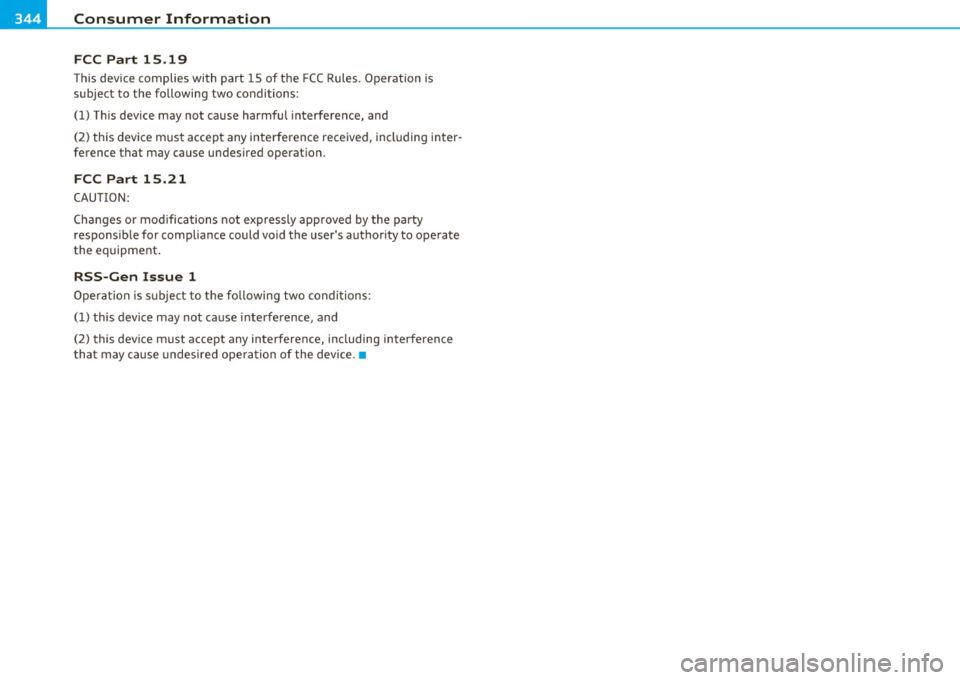
___ C_ o_n_ s _ u_m_ e_ r_ I_ n_ f_o _r_ m_ a_ t_io _ n _____________________________________________ _
FCC Part 15 .19
This device complies with part 15 o f the FCC Rules. Operation is
subject to the following two condi tions:
(1) This dev ice may not cause harmful interference, and
( 2 ) t his device mus t ac cept any inte rfe rence re ceived, incl uding in ter
ference th at may cause undes ired operat ion.
FCC Part 15.21
CAUTION:
Changes or modifications not exp ressly approved by the party
respons ib le for compliance could void the user's authority to ope rate
the equipment .
RSS-Gen Issue 1
Ope ra tion is s ubject to t he followi ng two condi tion s:
( 1 ) this device may not ca use i nterference, and
(2) this device m ust accept any interference, including interference
t ha t may c ause undesire d ope ra t ion of the device. •
Page 352 of 362
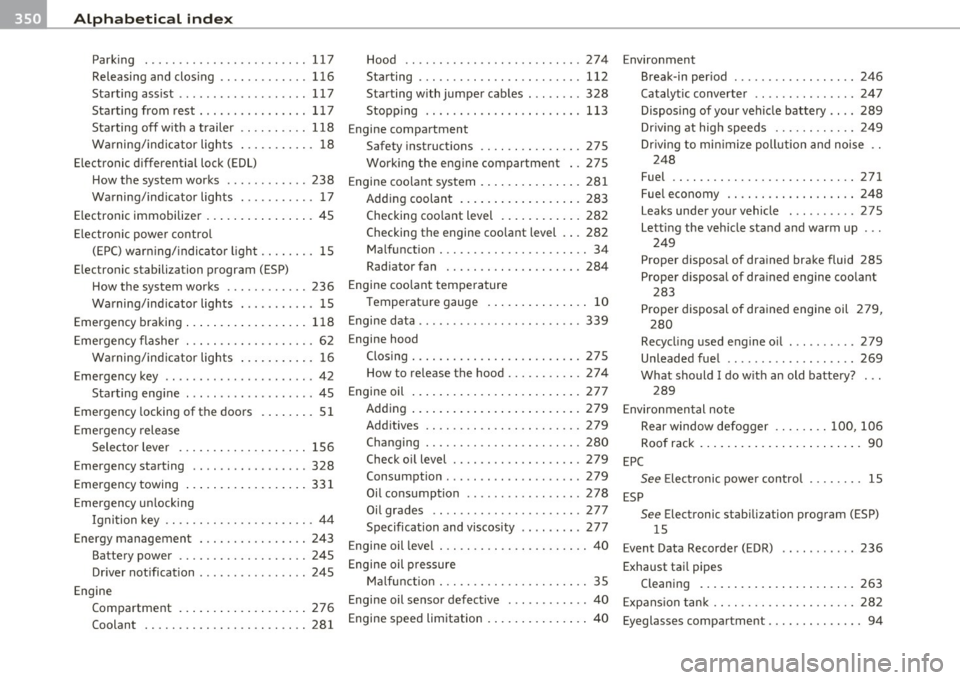
___ A_ l_. p_ h _ a_b_ e_ t_ic _a_ l_ in_ d_e _ x ____________________________________________ _
Parking ........ ..... .. .. .... ... 117 Hood .. .. .. .. .. .... ... . ... .. .. . 274
Releasing and clos ing .. .. ......... 116 Starting ........... .. .. .. ....... 112
Starting assist ................ ... 117 Sta rting with jumpe rr cab les ........ 328
Starting from rest . .. ...... ..... .. 117 Stopp ing ... .. ..... .... .. .. .. .. . 113
Sta rting off w ith a t railer ... . .. .. .. 118
Engine compartment
W arning/ind icator lights . .......... 18
Safety instruct ions .... .. .. .. .. ... 275
Elect ronic differential lock (EDL) Working the eng ine compartment . . 275
How the system works .... ... .. ... 238
Engine coo lant system . .. ... . ... .... . 281
Warning/ind icator lights . .......... 17
Adding coolant ... .... .. . .. ... .. . 283
Electronic immobilizer .. .. . ... ... .. ... 45
Checking coo la nt level . ..... ..... . 282
Electro nic powe r contro l Checking the engine coo
lant level . .. 282
( E PC) war ning/ indicato r light .. ...... 15 Ma
lfunction ... ................. .. 34
Electronic stabilization program (ESP) Radiator fan ...
...... .. .. .. .. ... 284
How the system works ............ 236 Engine coo
lant temperature
Wa rning/ind icator lights . .......... 15 T
emperat ure gauge . .... . ... .. .. . . 10
Emergency braking ..... .. .. .. .. .. ... 118 Engine data
... ... ...... ... .. .. .. .. . 339
Emergency flasher . . . . . . . . . . . . . . . . . . . 62
Engine hood
W arning/ind icator lights ... .. ... ... 16 Closing ........
...... ...... ..... 275
E mergency key .. ................ .... 42 How to re
lease the hood .......... . 2 7 4
Starting eng ine . .. .... .. ..... ..... 45 Engine oil
.... ..... ..... .... .. .. .. . 277
Emergency locking of the doors . ... .. .. 51 Adding ...
... .... .... .... ... . ... 279
Eme rgency release
Sele ctor leve r ............. .... .. 156 Add
itives ...... .. .. .. ...... .. ... 279
Changing ............ .... .. ..... 280
E mergency starting .. .. ... ....... ... 328
Emergency towing ..... .. .. ..... .... 331
Emergency u nlocking
Ignition key .. .... ............. ... 44
Energy management .......... .... .. 243
Battery power ................... 245
Dr iver not ification ..... .. .. ... .. .. 245 Check o
il level ............ .. .... . 279
Consumption ....... .. .. .. ....... 279
Oil consumption .... .... . ... .. .. . 278
Oi l grades .. ..... ............. .. 277
Specification and viscosity .. .. .. .. . 277
E ngine oil leve l ... .... ............. .. 40
E ngine oil pressure
M al fun ctio n ... ........... ...... .. 35
Engine
Compartment .. .. .. .. . ... ... .. .. 276
Coolant ...... .......... ...... .. 281 Engine oil sensor defec
tive ..... .. .. ... 40
Engine speed limitatiorn . ....... ..... .. 40 Environment
Break-in per iod ......... ... .. .. .. 246
Catalytic converte r ............... 24 7
Disposing of you r vehicl e battery .. .. 289
Dr iv ing at hig h speeds ............ 249
Dr iv ing to mi nimize poll ution and noise ..
248
Fuel .. .. .... ............. ...... 271
Fuel economy .. .... .... ... .. .. .. 248
Leaks under you r vehicle ... .. ... .. 275
Lett ing the vehicle stand and warm up ...
249
Proper disposa l of dra ined brake fluid 285
Proper disposal of d ra ined engine coo lant
283
Proper disposal of drained engine oil 279,
280
Recycl ing used e ng ine o il ... .. .. .. . 279
Unleaded fue l ............ ... .. .. 269
What should I do w it h an old batte ry?
289
E nvironmen tal note
Re ar w indow defogger ...... .. 100, 1 06
Roo f rack . . . . . . . . . . . . . . . . . . . . . . . . 90
EPC See Elect ronic power con tro l ........ 15
ESP See Electronic stabilization program (ESP)
15
Event Data Recorde r (EDR) 236
Exhaust tai l pipes
Cleaning ... .... ... .. . .... .... .. 263
E xp ans ion tank .. .. .. .. ............. 282
Eyeglasses compartment ......... . ... . 94